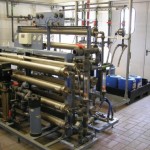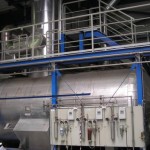To operate, the steam boiler and the steam turbine need deionised water that contains as little residual ions as possible. The raw water that comes from two own deep wells is cleared of the ions contained in the water by means of cation exchangers, a dual-stage reverse-osmosis plant and downstream mixed-bed filters.
 In this way, the raw water is fully demineralised. The use of acids and alkaline solutions as in conventional water treatment is not necessary. The cation exchangers are cleaned from time to time using the counter-flow method and regenerated with sodium chloride (NaCl).
In this way, the raw water is fully demineralised. The use of acids and alkaline solutions as in conventional water treatment is not necessary. The cation exchangers are cleaned from time to time using the counter-flow method and regenerated with sodium chloride (NaCl).
The water treatment installation has a permeate capacity of 2.5 cubic metres to 1.4 cubic metres of concentrate. The conductivity of the water downstream of the mixed-bed filter system is about 0.025 µS/cm, which is almost equal to the theoretical minimal conductivity of water (0.020 µS/cm). The result of this filtration process is deionised water which is then preheated in the low-pressure preheater and the feed water tank.
 We speak of feed water in the proper sense of the word only after the water has left the feed water tank. The feed water is then pumped into the boiler by the feed water pumps and in this way added to the water circuit. During the following evaporation and superheating process in the boiler, the steam reaches a temperature of 450°C at a pressure of 65 bar.
We speak of feed water in the proper sense of the word only after the water has left the feed water tank. The feed water is then pumped into the boiler by the feed water pumps and in this way added to the water circuit. During the following evaporation and superheating process in the boiler, the steam reaches a temperature of 450°C at a pressure of 65 bar.
As the circuit is closed, just small amounts of make-up water need to be added under normal conditions.